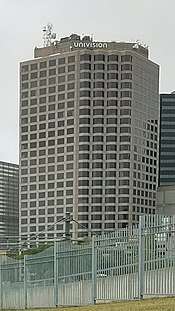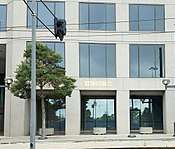KUVN-DT
 | |
| Garland/Dallas/Fort Worth, Texas United States | |
|---|---|
| City | Garland, Texas |
| Branding |
Univision 23 (general) Noticias 23 (newscasts) |
| Channels |
Digital: 23 (UHF) (to move to 33 (UHF)) Virtual: 23 (PSIP) |
| Translators | KUVN-CD 47, Fort Worth[1] |
| Affiliations | |
| Owner |
Univision Communications (KUVN License Partnership, LP) |
| First air date | September 25, 1986 |
| Call letters' meaning | UniVisioN |
| Sister station(s) |
TV: KSTR-TV Radio: KFZO, KESS-FM, KFLC, KDXX, KLNO |
| Former callsigns |
|
| Former channel number(s) |
|
| Former affiliations | SIN (1986–1987) |
| Transmitter power | 1,000 kW |
| Height | 517 m (1,696 ft) |
| Facility ID | 35841 |
| Transmitter coordinates | 32°35′21.00″N 96°58′12″W / 32.5891667°N 96.97000°WCoordinates: 32°35′21.00″N 96°58′12″W / 32.5891667°N 96.97000°W |
| Licensing authority | FCC |
| Public license information: |
Profile CDBS |
| Website | Univision 23 |
KUVN-DT, virtual and UHF digital channel 23, is a Univision owned-and-operated television station serving the Dallas–Fort Worth Metroplex that is licensed to Garland, Texas, United States. The station is owned by Univision Communications, as part of a duopoly with UniMás owned-and-operated station KSTR-DT (channel 49). The two stations share studio facilities located on Bryan Street in downtown Dallas; KUVN maintains transmitter facilities located south of Belt Line Road in Cedar Hill. The station's signal is relayed on Class A low-power station KUVN-CD (channel 47) in Fort Worth.
History
Prior history of UHF channel 23 in Dallas-Fort Worth
The UHF channel 23 allocation in the Dallas-Fort Worth market had originally been allocated for KDTX. Lakewood Broadcasting (owned by a coalition of local oilmen), who later signed on KGKO (1480 AM, now KBXD) in January 1953, was issued a construction permit to sign on the station in 1952; the station was never built, and the permit was deleted by the Federal Communications Commission in 1955.
The Richardson Independent School District then signed on an educational television station on channel 23 on February 29, 1960, KRET-TV. It was the first television station in the United States to be owned by a school district (beating KERA-TV (channel 13), which was founded by the Dallas Independent School District by eight months). Licensed to nearby Richardson, KRET only broadcast on weekdays during the school year for only two hours a day initially, before expanding to the entire school day; five-minute breaks were inserted between programs, which was filled by various pieces of music. Costing only $70,000 to build, it operated out of Richardson Junior High School, before moving to Richardson High School in 1963. Although operating on a full-power license, the station only provided a signal up to 20 miles from its transmitter. KRET-TV ceased operations in May 1970, and on August 31, was transitioned to the "TAGER" closed-circuit television system used for high school and college telecourses; the broadcast license was returned to the FCC.
KUVN-DT station history


The current television station licensed to channel 23 first signed on the air on September 25, 1986 as KIAB; it was founded by International American Broadcasting (owned by local ophthalmologist Dr. Elizabeth Vaughn). The station initially carried a mix of English-language religious programs sourced from the Christian Television Network during the morning hours, Spanish language programming from the Spanish International Network (which became Univision the following year) during the afternoon and evening hours, and programming from the Home Shopping Network during the overnight hours. The station originally operated from studios located on Marquis Street in Garland.
Vaughan sold KIAB to Univision in 1988, becoming the second commercial network owned-and-operated station in the Dallas market – after KDAF (channel 33; at the time, a charter O&O of Fox); following the purchase, the station changed its call letters to KUVN. At that point, channel 23 began running Univision programming 24 hours a day.
KUVN-CD
KUVN-CD's construction permit was originally owned by the American Christian Television System and was transferred to Bill Trammell in 1990. In 1994, the station's license was transferred to Rodriguez-Heftel-Texas; the deal was consummated on April 10, 1995. The license was transferred to KESS-TV License Corporation on May 16, 1996. The last transfer to date was (BALTTL-19960510IC) in 1996, in which it was sold to Univision. The station relocated its signal from UHF channel 31 to channel 47 in 2001. KUVN-LP was designated as a Class A low-power station and changed its call letters to KUVN-CA on March 1, 2002. KUVN-CD is not a repeater or a translator, as a Class A station cannot act as merely a repeater or translator. A construction permit was issued by the Federal Communications Commission on August 4, 2008 to allow then-KUVN-CA to operate a digital signal on channel 47, with an effective radiated power of 190 watts. The station was licensed for digital operation on June 3, 2015, and changed its call sign to KUVN-CD.
Digital television
Digital channels
The station's digital channel is multiplexed:
| Channel | Video | Aspect | PSIP Short Name | Programming[2] |
|---|---|---|---|---|
| 23.1 | 1080i | 16:9 | KUVN-DT | Main KUVN programming / Univision |
| 23.2 | 480i | 4:3 | Bounce | Bounce TV |
| 23.3 | ESCAPE | Escape | ||
| 23.4 | LAFF | Laff | ||
Analog-to-digital conversion
KUVN shut down its analog signal, over UHF channel 23, on June 12, 2009, as part of the federally mandated transition from analog to digital television.[3] The station's digital signal relocated from its pre-transition UHF channel 24 to channel 23. Prior to the shutdown of its analog signal, KUVN presented live coverage from Times Square showing the countdown to the nationwide digital transition.
News operation
KUVN-DT broadcasts 12 hours of locally produced newscasts each week (with two hours on weekdays and one hour each on Saturdays and Sundays). Following its acquisition by Univision, the network invested in a news department for the station and began producing nightly Spanish language local newscasts at 5:00 and 10:00 p.m. In the summer of 2010, KUVN introduced a new high-definition-ready graphics package for its newscasts, and began using a new news theme ("Univision 2006", which was based on the Mark Haffner-composed theme used from 1997 to 2001, "Turning Point") which is shared among many Univision affiliates in the United States and Puerto Rico.
On April 11, 2011, KUVN began broadcasting Primera Edicion and Vive La Mañana on Telefutura affiliate KSTR (channel 49). Like its newscasts at different times, it is broadcast in 480i standard definition, within their old studio set. Sister station KXLN-DT in Houston also uses the same titles for their newscasts; Vive La Mañana features a different graphics and music package shared by both KUVN and KXLN. In 2011, a new set for KUVN's newscasts was introduced. In 2012, KUVN began broadcasting its local newscasts in high definition.
On March 27, 2015, Univision announced it will replace Univision 23's morning newscast and Univision 45's Vive La Mañana with a regionalized morning newscast called Noticias Texas Primera Edicion that will air on Univision's stations in Dallas, Houston, San Antonio, and Austin from 4 am to 6 a.m., meaning that Univision 23's morning show would be cancelled; its last morning newscast was on Friday, March 27, 2015. The station's morning news anchors got relocated to Houston where the new regionalized morning newscast will air and where it is based. The station will also have morning news briefs and local, live cut-ins during Despierta America and the regionalized newscast. The regionalized newscast debuted on April 6, 2015; until then there were repeats of Noticiero Univision: Edicion Nocturna and entertainment programming.
References
External links
- Query the FCC's TV station database for KUVN-DT
- BIAfn's Media Web Database -- Information on KUVN-TV
- Query the FCC's TV station database for KUVN-CD